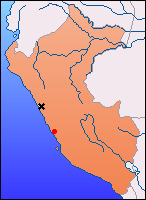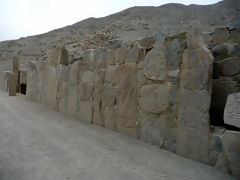 |
Related pages: |
 The Sechín archaeological complex, located in the Casma Valley in northern Peru, is one of the oldest sites in the country, dating back to around 1,600 BC. Discovered in 1937, Sechín is known for its fascinating stone bas-reliefs depicting violent scenes, likely related to rituals or warfare. This site remains a mystery to archaeologists, but it offers a captivating glimpse into pre-Columbian Peruvian culture.
The Sechín archaeological complex, located in the Casma Valley in northern Peru, is one of the oldest sites in the country, dating back to around 1,600 BC. Discovered in 1937, Sechín is known for its fascinating stone bas-reliefs depicting violent scenes, likely related to rituals or warfare. This site remains a mystery to archaeologists, but it offers a captivating glimpse into pre-Columbian Peruvian culture.
The Sechín site is part of a larger complex, called Cerro Sechín, which includes several monumental stone and adobe structures, as well as ceremonial plazas. The bas-reliefs carved into the stones at Sechín are among the most intriguing in all of South America, showing warriors, mutilated human figures, and decapitation scenes.
The walls of Sechín are adorned with impressive bas-reliefs that depict macabre scenes of warriors holding weapons and human heads. These striking images, unlike any others, continue to fascinate researchers who seek to understand their meaning. Some experts believe these representations depict ceremonies related to conflicts or human sacrifice rituals.
The bas-reliefs at Sechín are remarkably well-preserved and demonstrate a high level of skill in stone carving. Visitors to the site can view these works up close, offering a rare insight into the culture of this ancient period.
Sechín is considered one of the most important ceremonial centers on Peru’s northern coast. Archaeological findings suggest that the site served as a political and religious center for the Sechín culture, long before the rise of more well-known civilizations like the Moche or Chavín. The layout of the buildings and plazas indicates sophisticated planning, likely intended for collective rituals.
Archaeological excavations have also uncovered human remains and offerings that suggest complex rituals, possibly involving human sacrifices to appease the gods or to commemorate significant events.
The Sechín site was discovered by Peruvian archaeologist Julio C. Tello in 1937, who immediately recognized the historical significance of this find. Since then, Sechín has been the subject of numerous studies, but many questions remain unanswered, particularly regarding the site’s true function and the exact nature of the rituals practiced there.
Today, Sechín continues to attract archaeologists and tourists from around the world, eager to explore this ancient treasure and better understand the pre-Columbian societies of Peru.